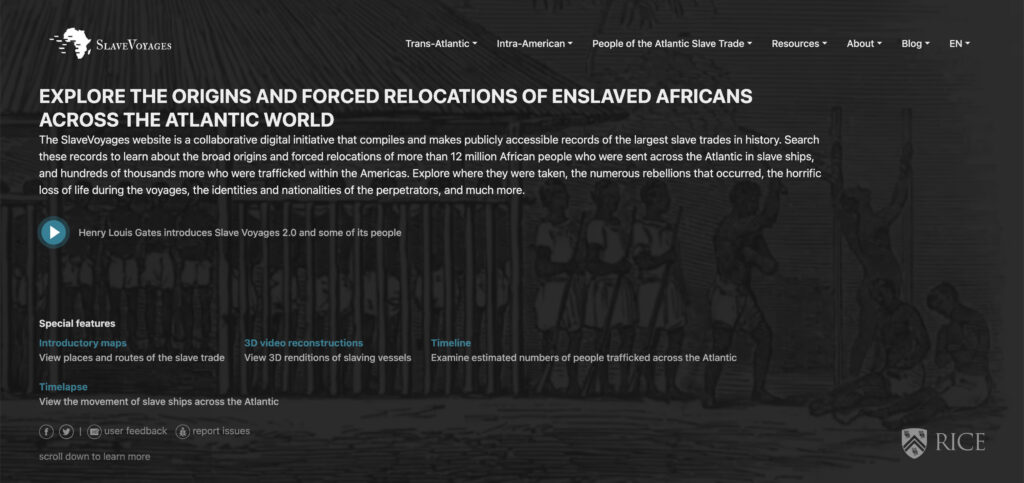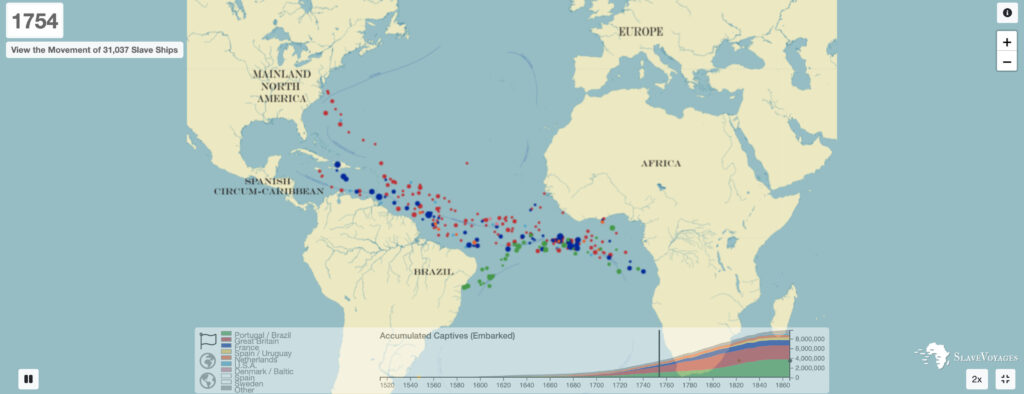SlaveVoyages

The transatlantic slave trade occurred over the course of over 300 years. In that span, countless individuals found themselves ripped away from their homes and taken to some far-off land. This terrible venture forced millions to be brought to another continent against their will. Yet, the scale, scope, and humanity of the slave trade still remains difficult to fully grasp. So many people made the journey against their will, yet one often hears little about who exactly these people were, where they went, and what their fate was. For many, the slave trade remains hidden behind shadowy figures, without many tangible connections and on such a large scale that is difficult to fully grasp. Simply put, the slave trade was a complex and enormous part of history. Yet, there exists a project which seeks to make this part of history more accessible and understandable for the everyday person: SlaveVoyages.
SlaveVoyages is a project, with the website currently hosted by Rice University, that seeks to gather and compile into databases both information about the Trans-Atlantic slave trade and the Inter-Atlantic slave trade, while also seeking to compile databases on the enslaved individuals themselves. Additionally, the project also seeks to educate on the slave trade. It provides the user with many visual aids, such as maps of where people came from, 3d renderings of slave ships, and even a timelapse where one can see the nationality of those transporting enslaved people, where they came from, and the flow of where they went.

Additionally, the site also has a timeline feature, where one can examine the scale and timeframe of the trade throughout different periods. Besides the databases, this project contains short essays explaining different parts of the trade. It also contains galleries where one can see the brutality firsthand and lesson plans for teachers desiring to explain the trade to their students.
This project follows a larger effort to create databases revolving around the slave trade. There had been many, but the idea for a singular, all-encompassing database, arose in 1990 when David Eltis and Stephen Behrendt met and, along with previous work, decided that it would be feasible. As time went on and grants became funded, the database was expanded with the help of countless individuals. The first version of the website was published in 2008, and it has since undergone renovations from 2015-2018 to craft it into the site seen today. While the databases have been compiled for quite some time, the site itself is still fairly new in the grand scheme of history. Since then, there have been multiple sets of teams that have contributed to the project and its database.
While not having an explicit argument, the project does have a goal of educating as many people as possible about the realities of the practice. Although in its current form, this project arose out of many different databases, using many different technologies. For instance, it follows a history where, in the 1960s, people started to collect archival data and code it into databases. Certainly, the technology has changed since then. While they use to rely on technology like CD-ROM’s to hold the information, that is now no longer the case. Now, with new sources of media, this data is able to exist online and be visualized, as well as exist in a database. The existence of it on the web has also allowed for the project to open up editing the database to anyone, as long as they go through a peer reviewed process. While the data was useful before, access to the internet has allowed it to spread as far as it can. America, as well, has had a difficult time coming to terms with its past, but this effort seems to follow a burgeoning endeavor to paint a complete picture of the trade and America’s persistent problem of dealing with race. Especially in the context of recent events in the United States with the Black Lives Matter movement, this project serves to illuminate an often-shadowy part of our past.
In that regard, this project accomplishes its goal beautifully. The media supporting the database is clean and efficient, with information being easily digestible and useful. The database is also extremely comprehensive, with people even being able to find the name of many enslaved people who made the journey. Although this only occurred in the last 60 years of the trade, the inclusion of their names and fates provides a real sense of humanity that is often forgotten when discussing those who came over. The inclusion of lesson plans also provides a simple and effective way for educators to discuss the topic. Although sometimes the database may be difficult to navigate, if one really attempts to understand the database, they will. The learning curve may be a little steep at first, but it quickly dissipates. Overall, this project is an extremely worthwhile endeavor, and accomplishes the goals it set out to do in an efficient, easy to use, and factual website.